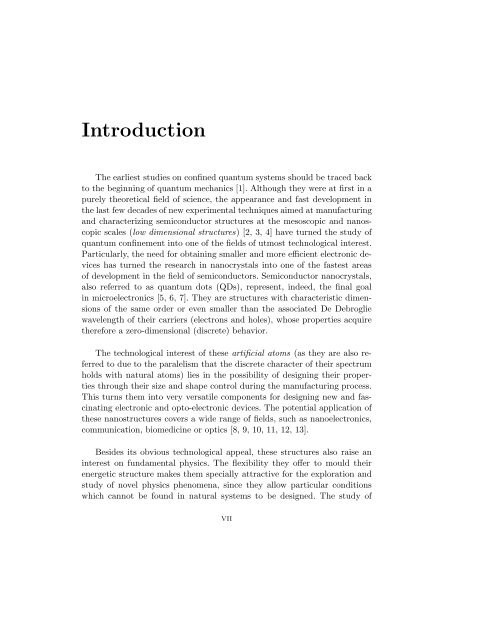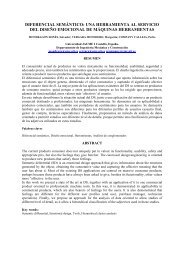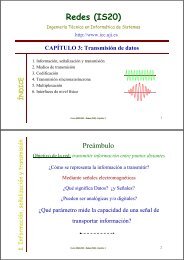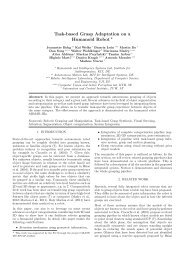- Page 1: CONFINAMIENTO NANOSCÓPICO ENESTRUC
- Page 5 and 6: AgradecimientosDecía Albert Einste
- Page 7: A mi madreA la memoria de mi padre
- Page 11 and 12: ixThis Thesis report is organized a
- Page 13 and 14: xiwith an off-centered inpurity: al
- Page 15 and 16: IntroducciónLos primeros estudios
- Page 17 and 18: xvespacial se ve superado en import
- Page 19: xviiEl listado que se ofrece a cont
- Page 24 and 25: 2 Capítulo 1: Fundamentos teórico
- Page 26 and 27: 4 Capítulo 1: Fundamentos teórico
- Page 28 and 29: 6 Capítulo 1: Fundamentos teórico
- Page 30 and 31: 8 Capítulo 1: Fundamentos teórico
- Page 32 and 33: 10 Capítulo 1: Fundamentos teóric
- Page 34 and 35: 12 Capítulo 1: Fundamentos teóric
- Page 36 and 37: 14 Capítulo 1: Fundamentos teóric
- Page 38 and 39: 16 Capítulo 1: Fundamentos teóric
- Page 40 and 41: 18 Capítulo 1: Fundamentos teóric
- Page 42 and 43: 20 Capítulo 1: Fundamentos teóric
- Page 44 and 45: 22 Capítulo 2: Confinamientos espa
- Page 46 and 47: 24 Capítulo 2: Confinamientos espa
- Page 48 and 49: 26 Capítulo 2: Confinamientos espa
- Page 50 and 51: 28 Capítulo 2: Confinamientos espa
- Page 52 and 53: 30 Capítulo 2: Confinamientos espa
- Page 54 and 55: 32 Capítulo 2: Confinamientos espa
- Page 56 and 57: 34 Capítulo 3: Confinamiento peri
- Page 58 and 59:
36 Capítulo 3: Confinamiento peri
- Page 60 and 61:
38 Capítulo 3: Confinamiento peri
- Page 62 and 63:
40 Capítulo 3: Confinamiento peri
- Page 64 and 65:
42 Capítulo 3: Confinamiento peri
- Page 66 and 67:
44 Capítulo 3: Confinamiento peri
- Page 68 and 69:
46 Capítulo 3: Confinamiento peri
- Page 70 and 71:
48 Capítulo 3: Confinamiento peri
- Page 72 and 73:
50 Capítulo 4: Confinamiento magn
- Page 74 and 75:
52 Capítulo 4: Confinamiento magn
- Page 76 and 77:
54 Capítulo 4: Confinamiento magn
- Page 78 and 79:
56 Capítulo 4: Confinamiento magn
- Page 80 and 81:
58 Capítulo 4: Confinamiento magn
- Page 82 and 83:
60 Capítulo 4: Confinamiento magn
- Page 84 and 85:
62 Capítulo 4: Confinamiento magn
- Page 86 and 87:
64 Capítulo 4: Confinamiento magn
- Page 88 and 89:
66 Capítulo 4: Confinamiento magn
- Page 90 and 91:
68 Capítulo 5: Confinamiento diel
- Page 92 and 93:
70 Capítulo 5: Confinamiento diel
- Page 94 and 95:
72 Capítulo 5: Confinamiento diel
- Page 96 and 97:
74 Capítulo 5: Confinamiento diel
- Page 98 and 99:
76 Capítulo 5: Confinamiento diel
- Page 100 and 101:
78 Capítulo 5: Confinamiento diel
- Page 102 and 103:
80 Capítulo 5: Confinamiento diel
- Page 104 and 105:
82 Capítulo 5: Confinamiento diel
- Page 106 and 107:
84 Capítulo 5: Confinamiento diel
- Page 108 and 109:
86 Capítulo 5: Confinamiento diel
- Page 110 and 111:
88 Capítulo 5: Confinamiento diel
- Page 112 and 113:
90 Capítulo 5: Confinamiento diel
- Page 114 and 115:
92 Capítulo 5: Confinamiento diel
- Page 116 and 117:
94 Capítulo 5: Confinamiento diel
- Page 118 and 119:
96 Capítulo 5: Confinamiento diel
- Page 120 and 121:
98 Capítulo 5: Confinamiento diel
- Page 122 and 123:
100 Capítulo 5: Confinamiento diel
- Page 124 and 125:
102 Capítulo 5: Confinamiento diel
- Page 126 and 127:
104 Capítulo 5: Confinamiento diel
- Page 128 and 129:
106 Capítulo 5: Confinamiento diel
- Page 130 and 131:
108 Capítulo 5: Confinamiento diel
- Page 132 and 133:
110 Capítulo 5: Confinamiento diel
- Page 134 and 135:
112 Capítulo 5: Confinamiento diel
- Page 136 and 137:
114 Capítulo 5: Confinamiento diel
- Page 138 and 139:
116 Capítulo 5: Confinamiento diel
- Page 140 and 141:
118 Capítulo 5: Confinamiento diel
- Page 142 and 143:
120 Capítulo 5: Confinamiento diel
- Page 144 and 145:
122 Capítulo 5: Confinamiento diel
- Page 146 and 147:
124 Capítulo 5: Confinamiento diel
- Page 148 and 149:
126 Capítulo 5: Confinamiento diel
- Page 150 and 151:
128 Capítulo 5: Confinamiento diel
- Page 152 and 153:
130 Capítulo 5: Confinamiento diel
- Page 154 and 155:
132 Capítulo 5: Confinamiento diel
- Page 156 and 157:
134 Capítulo 5: Confinamiento diel
- Page 158 and 159:
136 Capítulo 5: Confinamiento diel
- Page 160 and 161:
138 Capítulo 5: Confinamiento diel
- Page 162 and 163:
140 Capítulo 5: Confinamiento diel
- Page 164 and 165:
142 Capítulo 5: Confinamiento diel
- Page 166 and 167:
144 Capítulo 5: Confinamiento diel
- Page 168 and 169:
146 Capítulo 5: Confinamiento diel
- Page 170 and 171:
148 Capítulo 5: Confinamiento diel
- Page 172 and 173:
150 Capítulo 5: Confinamiento diel
- Page 174 and 175:
152 Capítulo 5: Confinamiento diel
- Page 176 and 177:
154 Conclusionesmos comparado con l
- Page 178 and 179:
156 ConclusionesEn quinto lugar, he
- Page 180 and 181:
158 Conclusiones
- Page 182 and 183:
160 Publicaciones
- Page 184 and 185:
162 Publicaciones
- Page 186 and 187:
164 Publicaciones4516 J. Appl. Phys
- Page 188 and 189:
166 Publicaciones4518 J. Appl. Phys
- Page 190 and 191:
168 Publicaciones
- Page 192 and 193:
170 Publicaciones
- Page 194 and 195:
172 Publicaciones13288 J. Phys. Che
- Page 196 and 197:
174 Publicaciones13290 J. Phys. Che
- Page 198 and 199:
176 Publicaciones
- Page 200 and 201:
178 Publicaciones
- Page 202 and 203:
180 Publicaciones224 J. Planelles,
- Page 204 and 205:
182 Publicaciones226 J. Planelles,
- Page 206 and 207:
184 Publicaciones228 J. Planelles,
- Page 208 and 209:
186 Publicaciones230 J. Planelles,
- Page 210 and 211:
188 PublicacionesCLIMENTE, PLANELLE
- Page 212 and 213:
190 PublicacionesCLIMENTE, PLANELLE
- Page 214 and 215:
192 Publicaciones9372. Theoretical
- Page 216 and 217:
194 Publicaciones939is essentially
- Page 218 and 219:
196 Publicaciones941depending on th
- Page 220 and 221:
198 Publicaciones
- Page 222 and 223:
200 PublicacionesJ.L. Movilla, J. P
- Page 224 and 225:
202 PublicacionesJ.L. Movilla, J. P
- Page 226 and 227:
204 PublicacionesJ.L. Movilla, J. P
- Page 228 and 229:
206 PublicacionesJ.L. Movilla, J. P
- Page 230 and 231:
208 Publicaciones
- Page 232 and 233:
210 PublicacionesJ. L. MOVILLA AND
- Page 234 and 235:
212 PublicacionesJ. L. MOVILLA AND
- Page 236 and 237:
214 PublicacionesJ. L. MOVILLA AND
- Page 238 and 239:
216 Publicaciones
- Page 240 and 241:
218 PublicacionesBRIEF REPORTSconse
- Page 242 and 243:
220 PublicacionesBRIEF REPORTSB 66,
- Page 244 and 245:
222 PublicacionesJ. PLANELLES AND J
- Page 246 and 247:
224 PublicacionesJ. PLANELLES AND J
- Page 248 and 249:
226 Publicacionesfields such as chr
- Page 250 and 251:
228 Publicacionesdescription of V s
- Page 252 and 253:
230 Publicaciones2.3 Computational
- Page 254 and 255:
232 Publicacionesas whether the ele
- Page 256 and 257:
234 Publicacionesin Fig. 2 we plot
- Page 258 and 259:
236 Publicaciones(a)(b)ρ (r)ρ (r)
- Page 260 and 261:
238 Publicacionesno relevant amount
- Page 262 and 263:
240 Publicaciones[31] L. Bányai, P
- Page 264 and 265:
242 Publicaciones
- Page 266 and 267:
244 PublicacionesMOVILLA, PLANELLES
- Page 268 and 269:
246 PublicacionesMOVILLA, PLANELLES
- Page 270 and 271:
248 PublicacionesRAJADELL et al.fun
- Page 272 and 273:
250 PublicacionesRAJADELL et al.*ex
- Page 274 and 275:
252 Publicaciones
- Page 276 and 277:
254 PublicacionesJ. L. MOVILLA AND
- Page 278 and 279:
256 PublicacionesJ. L. MOVILLA AND
- Page 280 and 281:
258 PublicacionesJ. L. MOVILLA AND
- Page 282 and 283:
260 PublicacionesJ. L. MOVILLA AND
- Page 284 and 285:
262 Publicaciones
- Page 286 and 287:
264 PublicacionesJ. L. MOVILLA AND
- Page 288 and 289:
266 PublicacionesJ. L. MOVILLA AND
- Page 290 and 291:
268 PublicacionesJ. L. MOVILLA AND
- Page 292 and 293:
270 Publicaciones2 J.L. Movilla and
- Page 294 and 295:
272 Publicaciones4 J.L. Movilla and
- Page 296 and 297:
274 Publicaciones6 J.L. Movilla and
- Page 298 and 299:
276 Publicaciones8 J.L. Movilla and
- Page 300 and 301:
278 Publicaciones10 J.L. Movilla an
- Page 302 and 303:
280 Publicaciones12 J.L. Movilla an
- Page 304 and 305:
282 Publicaciones14 J.L. Movilla an
- Page 306 and 307:
284 Publicaciones16 J.L. Movilla an
- Page 308 and 309:
286 Publicaciones18 J.L. Movilla an
- Page 310 and 311:
288 Publicaciones20 J.L. Movilla an
- Page 312 and 313:
290 Publicaciones22 J.L. Movilla an
- Page 314 and 315:
292 Publicaciones24 J.L. Movilla an
- Page 316 and 317:
294 BIBLIOGRAFÍA[11] X.Q. Li y Y.
- Page 318 and 319:
296 BIBLIOGRAFÍA[36] J.L. Movilla
- Page 320 and 321:
298 BIBLIOGRAFÍA[60] J. Planelles
- Page 322 and 323:
300 BIBLIOGRAFÍA[85] Y. Arakawa y
- Page 324 and 325:
302 BIBLIOGRAFÍA[108] P. Ballet, J
- Page 326 and 327:
304 BIBLIOGRAFÍA[133] A. Lorke y R
- Page 328 and 329:
306 BIBLIOGRAFÍA[157] M. Wagner, U
- Page 330 and 331:
308 BIBLIOGRAFÍA[181] J. Planelles
- Page 332 and 333:
310 BIBLIOGRAFÍA[207] L. Bányai y
- Page 334 and 335:
312 BIBLIOGRAFÍA[232] J.L. Zhu,“
- Page 336 and 337:
314 BIBLIOGRAFÍA[255] T. Dittrich,
- Page 338 and 339:
316 BIBLIOGRAFÍA[278] J.N. Bremmer
- Page 340 and 341:
318 BIBLIOGRAFÍA[301] J.G.S. Lok,
- Page 342:
320 BIBLIOGRAFÍA
















